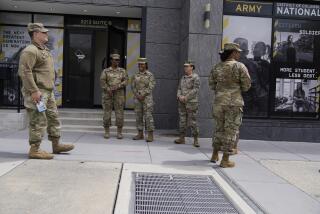Postal Service Plans to Cut 47,000 Jobs by 1995 : Workplace: The reductions--part of a major shift to automated sorting--will be accomplished by attrition, the postmaster says.
WASHINGTON — Postmaster General Anthony M. Frank said Thursday that the Postal Service will eliminate 47,000 jobs by 1995 through an ambitious automation program, but he expressed confidence that the reductions can be achieved by attrition.
Frank also said if the first-class letter rate, now 29 cents, is increased to 30 cents, no further price hikes would be needed until 1995.
“The biggest automation program in history” will be virtually completed by 1995, when almost all mail will be processed with a computerized bar code marked on the envelope for rapid sorting and easy delivery, Frank said.
The Postal Service has eliminated 37,000 jobs in the past two years through a hiring freeze, and Frank had indicated in private meetings with union officials that the organization sought further reductions.
But Thursday’s announcement was the first public disclosure that the Postal Service plans to wipe out another 47,000 jobs. The new cutbacks, which will reduce the agency’s payroll to 703,000, will have a direct impact on mail carriers for the first time.
These workers now spend about four hours in the office sorting mail, and four hours on the streets delivering it. Automation, with more mail sorted in advance because of the computer bar codes, will cut the time in the office to two hours. The carriers, with six hours on the street, will be expected to cover longer routes.
The carriers will begin working on their new routes in 1993, Frank said during a meeting with reporters.
The automation program should not affect most individuals sending personal letters and cards. There will be no change in the current five-digit ZIP code for addresses.
The Postal Service is developing machinery that can read handwriting, and hopes to have the device available by 1995. It would scan the handwritten address at the post office, and then spray on the envelope a bar code--a series of vertical lines--translating the address into computerized language for rapid sorting and easy delivery.
The job cutbacks will save the Postal Service $4.5 billion a year in salary and benefits by 1995, Frank said. The savings should keep postage costs stable, he predicted.
The 29-cent rate for a first-class letter, in effect since February, was adopted by the independent Postal Rate Commission over the protests of the Postal Service, which had asked for 30 cents. Frank appealed the decision to the commission, but was turned down once. He is now awaiting the result of a second appeal. If he is turned down again by the commission, the Postal Service’s own Board of Governors could adopt the 30-cent rate by a unanimous vote.
A 30-cent rate, if finally approved, probably would not take effect until next February, Frank indicated. No additional increases would be needed until February, 1995, he predicted.
The news of job reductions was viewed by postal unions as inevitable.
“We welcome the opportunity to work to make this change as productive as possible,” said Vincent Sombrotto, president of the National Assn. of Letter Carriers, with 236,000 members.
“I don’t see it as a major problem at this time. . . . . Throughout the years, there have been carriers who have worked six hours or more on the street. This is not a revolution.” Moe Biller, president of the American Postal Workers Union, which represents 345,000 clerks, maintenance employees, motor vehicle employees, and special delivery messengers, said: “We know automation is here to stay.” But he added that there “doesn’t have to be a loss of jobs.”
The Postal Service will switch some workers to different jobs, and will move personnel to different work shifts.
More to Read
Sign up for Essential California
The most important California stories and recommendations in your inbox every morning.
You may occasionally receive promotional content from the Los Angeles Times.










